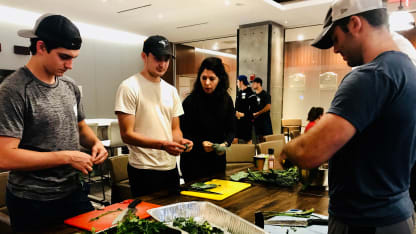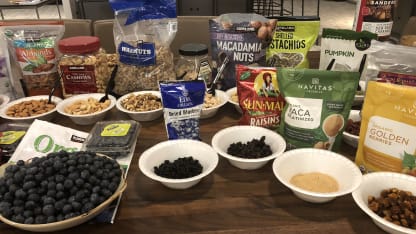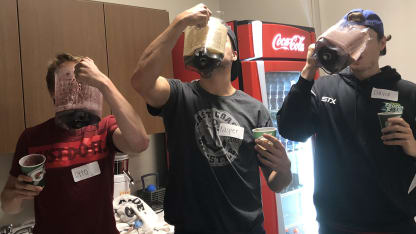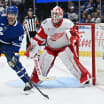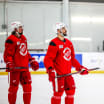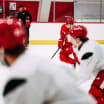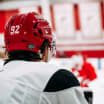"I put too much kale," Cholowski said, grimacing.
"Mine tastes like a garden," Fraser said, laughing as he tried his concoction.
The smoothies generally had some protein powder, superfood blends, kale and spinach, chia seeds, nut butters, berries, bananas, coconut water and ice.
The overnight oats station had the players select ingredients to go along with their oats and almond milk. There were several varieties of nuts, dried fruits like raisins and goji berries, maca powder, collagen, flaxseed, natural sweeteners like raw honey and some healthy fats.
After learning how to chop vegetables with some extremely sharp chef's knives, McDowell gave the youngsters some ideas when shopping for quick, easy-to-prepare meals.
McDowell emphasized that you can get packages of ancient grains, lentils, quinoa and pasta that can be heated up in 60-90 seconds.
When sitting with the group of three Swedes and a Swiss -- forward Jonatan Berggren, defenseman Alfons Malmstrom and goaltenders Jesper Eliasson and Joren van Pottelberghe -- McDowell noted that the Nordic diet was generally healthier than the traditional American one.
"Sweden is phenomenal," McDowell said.
She encouraged them to eat things like sardines as smaller fish have fewer contaminants like mercury and to add sauces like vindaloo and coconut curry, which contain curcumin, which is anti-inflammatory.
After going through the six stations, the players got to enjoy a meal prepared with many of the things they had seen during the class.
"Many of them have not tried a lot of the foods that we have tonight," McDowell said. "We have five different grains, we have 10 different fruits and vegetables, we have the cooking techniques so they're learning from expert chefs how to prepare salmon and chicken, which is often found in the athlete's diet. And learning how to chop properly so we want them to cut up vegetables, we want them to know how to use a knife and to feel comfortable. When they eat out, you see that they're just not getting high-quality food most of the time.
"So having the ability to know how to put a meal together in five or 10 minutes is essential. So what I did is I bought a lot of foods that have an instant option that's ready in 60 or 90 seconds to show them how simple it is to put together, how to rip kale apart so they can add greens to every meal - or spinach so they're getting their leafy greens and good quality grains, good carbohydrates for blood sugar control so they're not spiking and dropping."
For players like Cholowski, this is his third time at development camp but that doesn't mean he isn't learning something new.
"I learned I'm not good at making smoothies," Cholowski said, laughing. "But I learned it's quite easy to make salmon. I'm going to have to start doing it."
For first-timer Otto Kivenmaki, everything was new.
"I learned to do a smoothie," Kivenmaki said. "It's something I will do back home."
